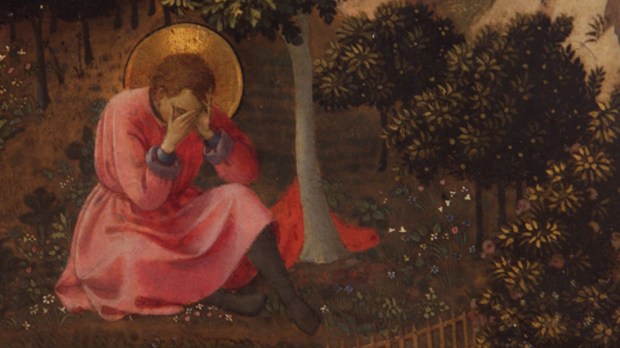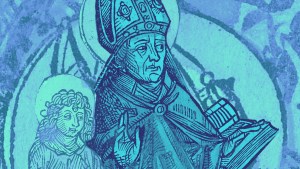It is appropriate to begin a piece on Augustine’s Confessions with a confession: I am only now — 15 years after my own reversion to the Catholic faith and several years into working professionally in bookish ministry — reading it cover to cover. I must have read portions of it in college, but likely just the bare minimum to get by in class. I tried picking it up a few years after my reversion, but found it too dense to see it through. And over the years, I read so many of its passages and heard it discussed so often that — as often happens with the classics — I felt as though I had read it already.
I hadn’t. And reading the text in full for the first time, what has bowled me over is just how relevant Augustine’s journey is, even in the high formal style of the Sheed translation. In fact, with a few small adjustments — swap Carthage with New York or LA, rhetoric with business administration or marketing, Manicheanism with occultism or spiritual-but-not-religious — one could easily be reading a contemporary conversion memoir.
Here are just 10 of the powerful lessons for today’s spiritual seekers and social influencers from this masterpiece.
#1: Our hearts are restless.
On the very first page, Augustine delivers one of the most devastating lines in all of literature: “Thou hast made us for Thyself and our hearts are restless till they rest in Thee” (1.1). Not my heart, but our hearts; and not were restless, but are restless. But as much as the restless heart is a universal, perennial human truth — “Man is a great deep, Lord” (4.14) — the digital age has exposed it like never before. We flitter from meme to meme, idea to idea, passion to passion — but to what end? “Where are you going? … Rest is not where you seek it. Seek what you seek, but it is not where you seek it. You seek happiness in the land of death, and it is not there” (4.12).
#2: We’re not that innocent.
Augustine is routinely pilloried as patient zero for Christian pessimism. He one-sidedly stresses sin and wretchedness, the story goes, leaving us with a negative view of human nature. But while Augustine does stress these themes, he is no dour pessimist; no, he is a tough realist. We see our own evil and anguish reflected in his journey, which is precisely why he makes us squirm. His account in book 2 of stealing pears from a pear tree with his friends at 16 — not even to eat it, but just for the thrill of it — is unforgettable, because every sinner knows exactly what he is describing. We all have our pear trees.
#3: Prayer works.
For the atheist, prayer is a waste of valuable time that would be much better spent taking concrete action. But the tearful prayers and patient accompaniment of Augustine’s mother, Monica, throughout the Confessions shows that the dilemma is a false one. Prayer is action — in fact, the ultimate action — because prayer works. The long-suffering Monica prayed for 17 years that her son might find his way back into the Church, and her prayer was answered. “You heard her, Lord. You heard her and did not despise her tears” (3.11). Those earnestly seeking God ought to open themselves to this very real power.
#4: God writes straight with our crooked lines.
The Confessions are marked by strange, painful turns in Augustine’s long and winding road to Christ and his Church: He joins up with the Gnostic Manicheans, having to untangle himself from their views for years to come (books three and seven); he mourns the sudden death of a good friend, who — after getting baptized shortly before his death — looks at Augustine as a “deadly enemy” when Augustine mocks him for it (4.4); he is driven, for purely practical and circumstantial reasons, from Carthage to Rome, and from there to Milan, nearly dying along the way. But the Confessions show us that even in our folly, stumbling, and happenstance, God is working out his providential design. We only see the mangled, confused back side of the beautiful tapestry he is weaving.
#5: We need a great spiritual teacher.
There is no St. Augustine without St. Ambrose, the great Bishop of Milan who guided Augustine out of his errors and into the Catholic faith. “All unknowing I was brought by God to him, that knowing I should be brought by him to God” (5.13). A do-it-yourself spiritual program is a dead end, one that inevitably makes us victims of our own personal frustrations and blind spots. If it’s truth that we want, placing ourselves, as Augustine did, under the tutelage of a wise and holy teacher will take us further up and further in.
#6: The Scriptures are profoundly true — but also truly profound.
At the heart of Ambrose’s impact on Augustine is his opening up of the spiritual sense of Scripture. Like so many atheists and agnostics today, Augustine the Manichean read Scripture in a hasty, superficial way, mocking its surface meanings as unsophisticated. But Ambrose patiently and lovingly drew aside “the veil of mystery” in the Bible, revealing spiritual and moral depths that Augustine never knew were there. He comes to marvel in its “twofold quality”: “It offers itself to all in the plainest words and the simplest expressions, yet demands the closest attention of the most serious minds. … It stands so lofty in authority yet draws the multitude to its bosom by its holy lowliness” (6.5).
#7: The life of the mind is good, helpful, and perfectly compatible with Christianity.
One of the most engaging qualities of the Confessions is how often Augustine poses really good and difficult questions — evidence of a hungry mind as much as a hungry heart. Indeed, his journey from Manicheanism into Christianity was bridged by the Platonists, who opened his mind to an incorporeal God, making faith in an incarnate God conceivable to him (7.7–17). It is well, he adds, that he was formed by the Platonists before Scripture, even as he admits the inadequacy of the former, because they might have “swept me away from the solid ground of piety” (7.20). Augustine thus gives us, at one and the same time, both a powerful endorsement of reason and an insistence on the primacy of revelation.
#8: Living for prestige and praise will leave us addicted and unhappy.
“The only difference between the saint and the sinner,” Oscar Wilde wrote, “is that every saint has a past and every sinner has a future.” Before he was a saint, Augustine was a marathon sinner, sunken in what he calls the “region of unlikeness” (an image borrowed from Plato). One temptation that had a special grip on Augustine’s soul — a temptation with which the social media world is now rife — was the lust for prestige and praise. In one poignant passage, he admits to dedicating a book to a famous orator just because the man seemed impressive (4.14). Later, Augustine sees a drunken beggar, realizing that his own ambition — a buzz he could never sleep off — made him far more miserable than the beggar would ever be (6.6). The endless hamster wheel wanting to be liked and admired only exhausts and, in the end, destroys us.
#9: Sex is good, but it is not the ultimate good.
Augustine’s insatiable hunger for praise was outpaced only by his hunger for sexual pleasure. He was, in his own words, a “slave to lust” (6.15). Christianity, unlike Manicheanism, did not view marriage or sex themselves as evil — Augustine knew this — yet, right up to the edge of his conversion, it was his attachment to sex that kept him from giving himself to God: “Grant me chastity and continence, but not yet” (8.7). The summit of Augustine’s spiritual journey was a toppling of this stubborn idol — a struggle with profound relevance for our own culture.
#10: Conversion is communal.
Augustine is seen as a paragon of inwardness — a forerunner of modern introspection and even existential angst. We see him in our mind’s eye as in Fra Angelico’s famous portrait: shedding copious tears in solitude under that fig tree, experiencing, personally, the love of Jesus. But what is usually cropped out of the image is his companion Alypius standing just to his left — who, the Confessions tell us, was converted side by side with Augustine. Indeed, his whole journey is marked by this deeply communal character: with him in the days before his conversion is also Simplicianus, who tells him of the conversion of Victorinus, and Ponticianus, who tells him of the conversion of two men inspired by St. Anthony — both stories igniting flames in Augustine’s heart. Augustine passes on the flame: in the wake of his conversion, he establishes a community of believers to pray and worship together, his heart longing for the Manicheans of his past to be converted too (9.4). We are not saved alone.


